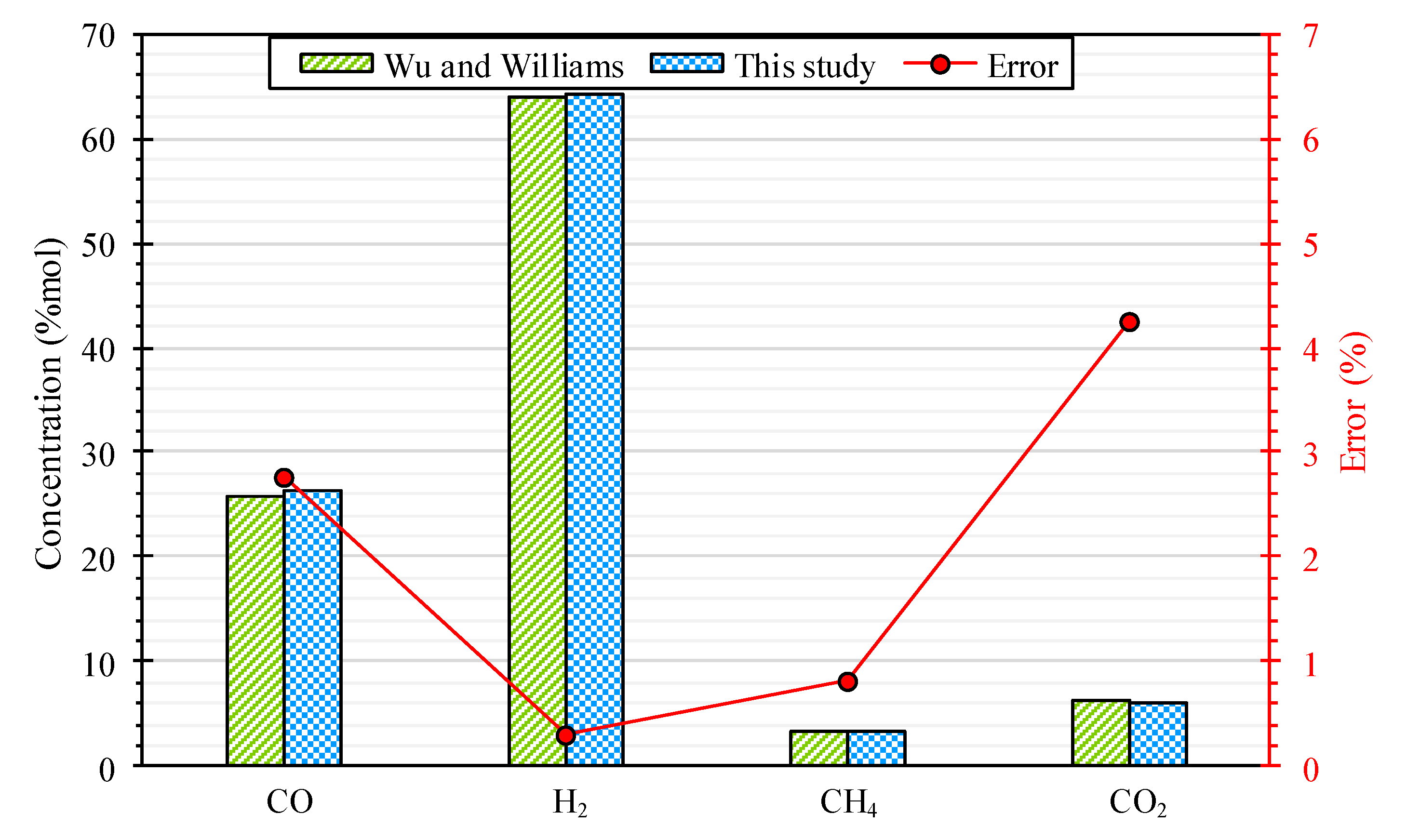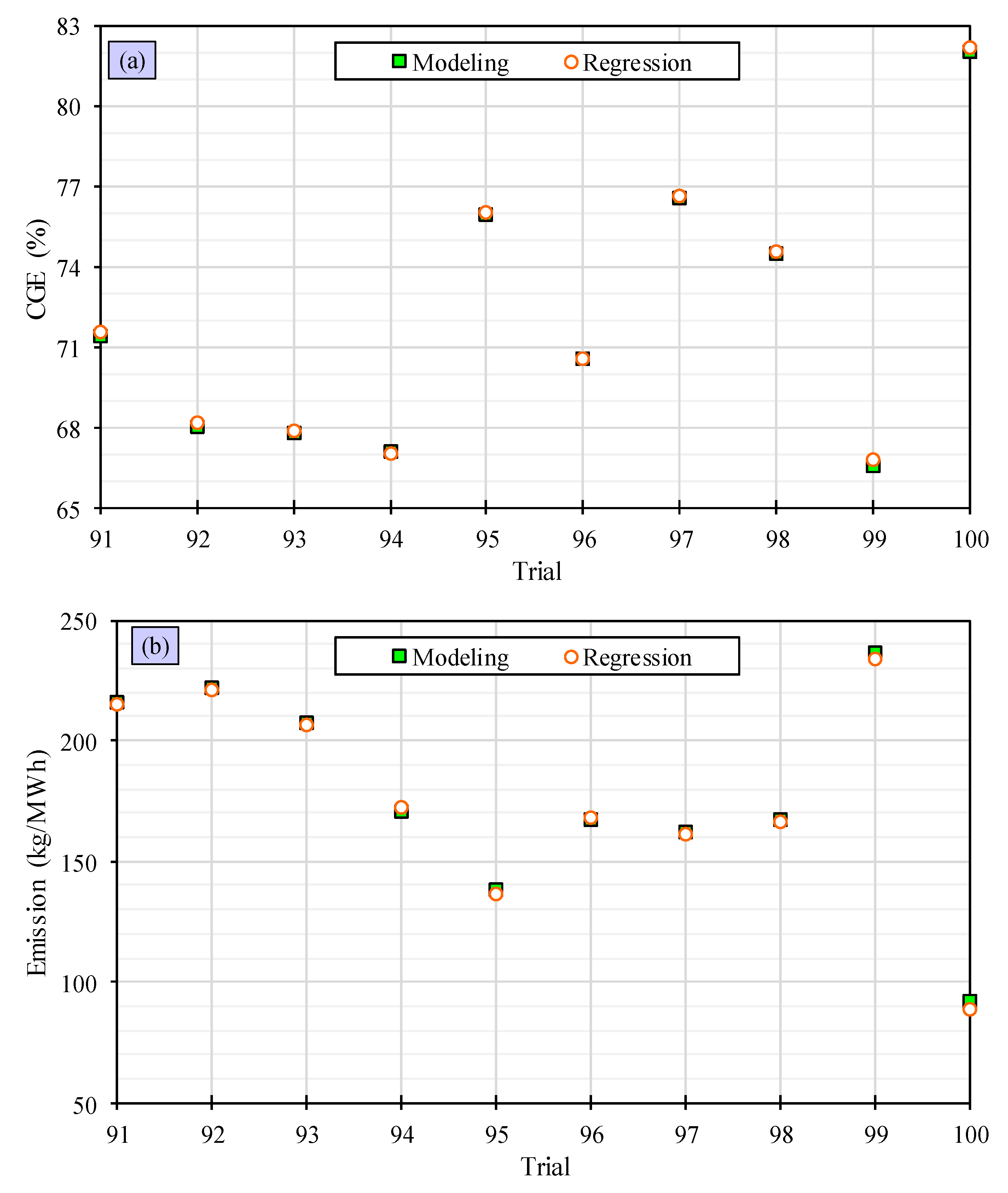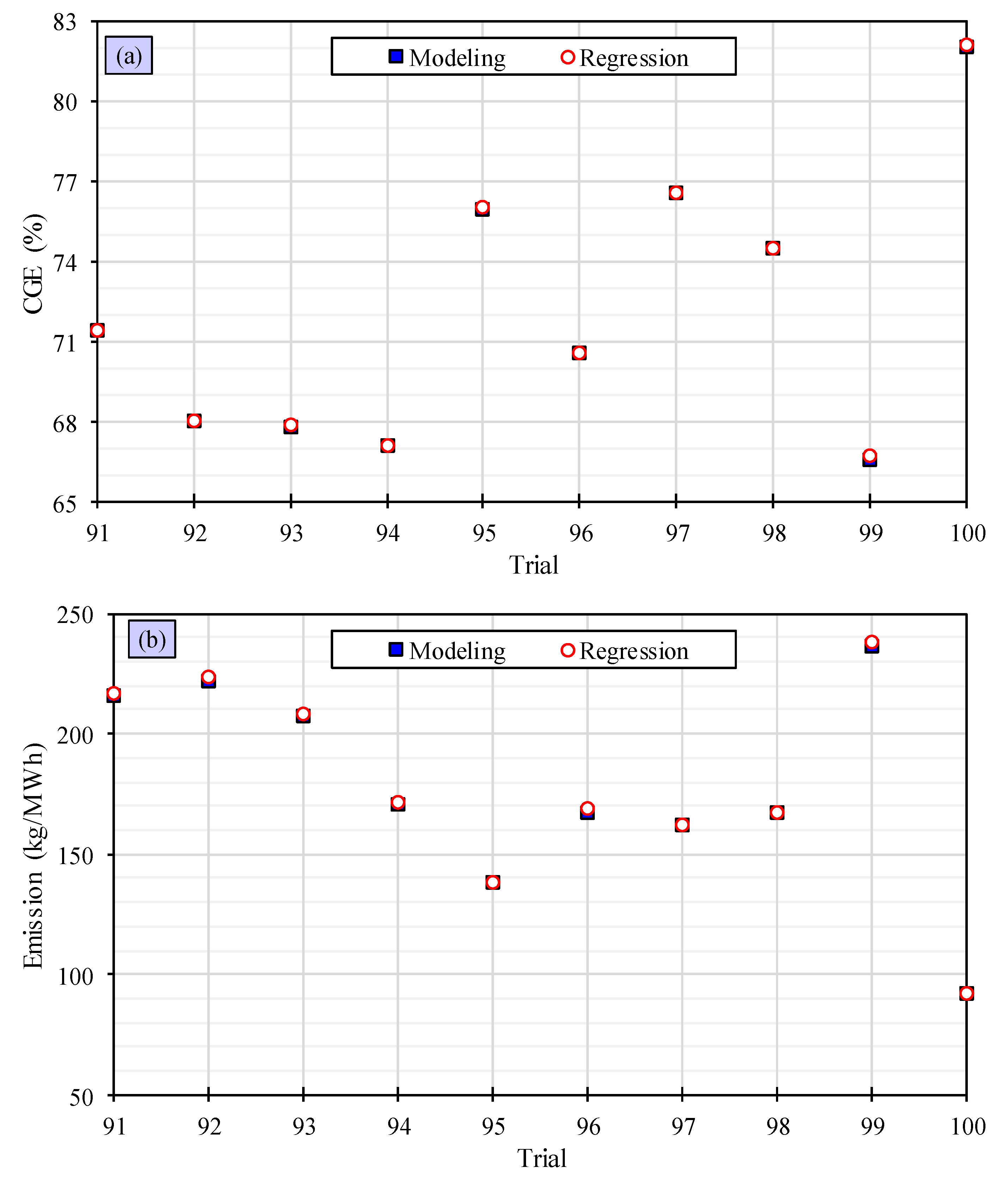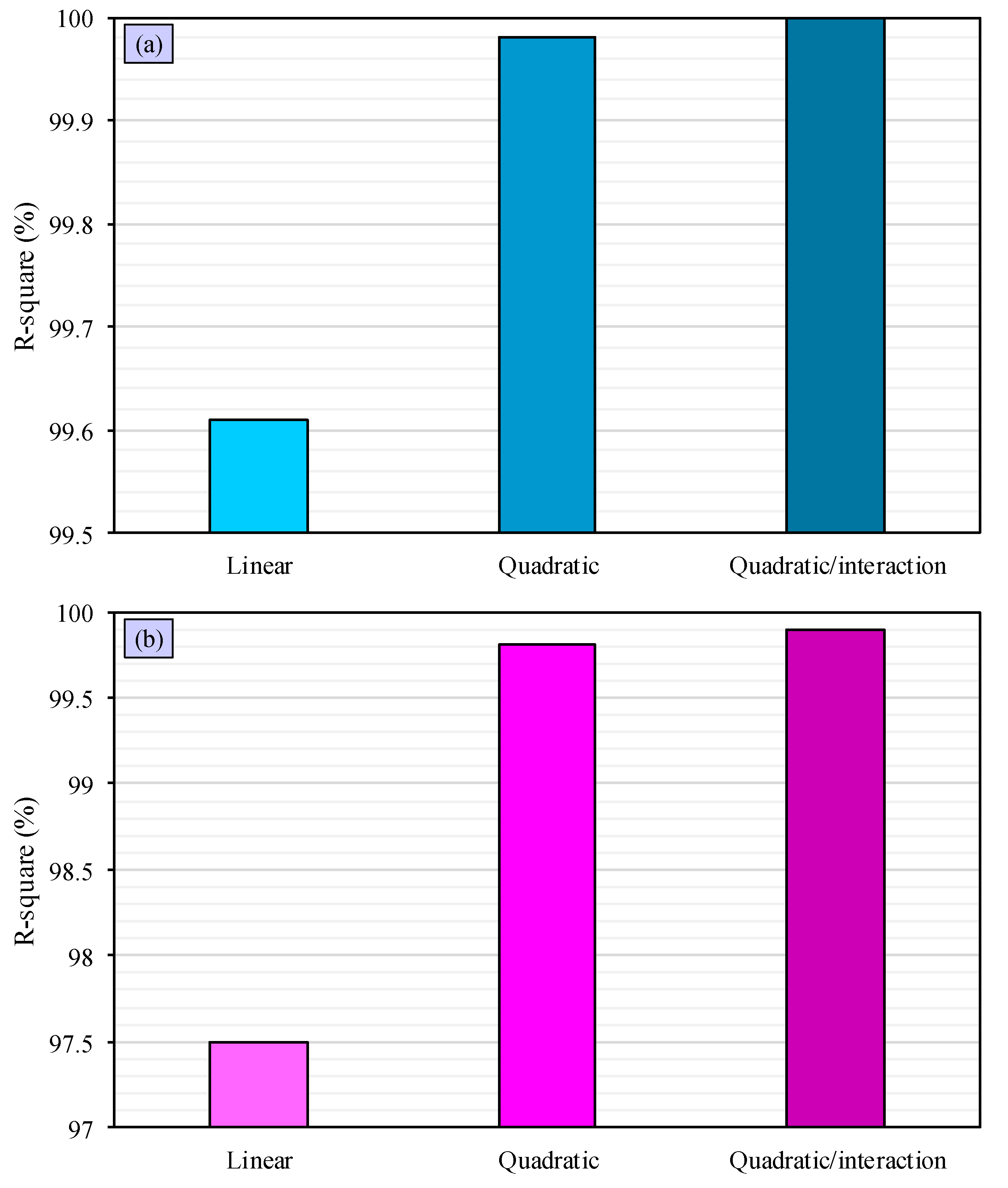A Regression Analysis on Steam Gasification of Polyvinyl Chloride Waste for an Efficient and Environmentally Sustainable Process
Abstract
:1. Introduction
2. Machine Learning Algorithm
3. Gasification of PVC Waste
4. Results and Discussion
4.1. Validation of Gasification Modeling
4.2. Process Evaluation
4.3. Machine Learning Study
5. Conclusions
Author Contributions
Funding
Institutional Review Board Statement
Informed Consent Statement
Data Availability Statement
Conflicts of Interest
References
- Fang, Y.K.; Wang, H.C.; Fang, P.H.; Liang, B.; Zheng, K.; Sun, Q.; Li, X.Q.; Zeng, R.; Wang, A.J. Life cycle assessment of integrated bioelectrochemical-constructed wetland system: Environmental sustainability and economic feasibility evaluation. Resour. Conserv. Recycl. 2023, 189, 106740. [Google Scholar] [CrossRef]
- Yang, R.X.; Jan, K.; Chen, C.T.; Chen, W.T.; Wu, K.C.W. Thermochemical conversion of plastic waste into fuels, chemicals, and value-added materials: A critical review and outlooks. ChemSusChem 2022, 15, 202200171. [Google Scholar] [CrossRef]
- Zhao, X.; Korey, M.; Li, K.; Copenhaver, K.; Tekinalp, H.; Celik, S.; Kalaitzidou, K.; Ruan, R.; Ragauskas, A.J.; Ozcan, S. Plastic waste upcycling toward a circular economy. Chem. Eng. J. 2022, 428, 131928. [Google Scholar] [CrossRef]
- Malik, S.; Maurya, A.; Khare, S.K.; Srivastava, K.R. Computational exploration of bio-degradation patterns of various plastic types. Polymers 2023, 15, 1540. [Google Scholar] [CrossRef]
- Xu, X.; Wang, C.; Zhou, P. GVRP considered oil-gas recovery in refined oil distribution: From an environmental perspective. Int. J. Prod. Econ. 2021, 235, 108078. [Google Scholar] [CrossRef]
- Ding, Q.; Zhu, H. The key to solving plastic packaging wastes: Design for recycling and recycling technology. Polymers 2023, 15, 1485. [Google Scholar] [CrossRef] [PubMed]
- Delaeter, C.; Spilmont, N.; Bouchet, V.M.; Seuront, L. Plastic leachates: Bridging the gap between a conspicuous pollution and its pernicious effects on marine life. Sci. Total Environ. 2022, 826, 154091. [Google Scholar] [CrossRef]
- Rodrigues, M.O.; Abrantes, N.; Gonçalves, F.J.M.; Nogueira, H.; Marques, J.C.; Gonçalves, A.M.M. Impacts of plastic products used in daily life on the environment and human health: What is known? Environ. Toxicol. Pharmacol. 2019, 72, 103239. [Google Scholar] [CrossRef]
- Zhao, S.; Li, H.; Wang, B.; Yang, X.; Peng, Y.; Du, H.; Zhang, Y.; Han, D.; Li, Z. Recent advances on syngas conversion targeting light olefins. Fuel 2022, 321, 124124. [Google Scholar] [CrossRef]
- Liang, Y.; Tan, Q.; Song, Q.; Li, J. An analysis of the plastic waste trade and management in Asia. Waste Manag. 2021, 119, 242–253. [Google Scholar] [CrossRef]
- Yu, D.; Wan, X.; Gu, B. Bi-objective optimization of biomass solid waste energy system with a solid oxide fuel cell. Chemosphere 2023, 323, 138182. [Google Scholar] [CrossRef]
- Lomwongsopon, P.; Varrone, C. Critical review on the progress of plastic bioupcycling technology as a potential solution for sustainable plastic waste management. Polymers 2022, 14, 4996. [Google Scholar] [CrossRef] [PubMed]
- Kwon, G.; Cho, D.W.; Park, J.; Bhatnagar, A.; Song, H. A review of plastic pollution and their treatment technology: A circular economy platform by thermochemical pathway. Chem. Eng. J. 2023, 464, 142771. [Google Scholar] [CrossRef]
- Cudjoe, D.; Wang, H. Plasma gasification versus incineration of plastic waste: Energy, economic and environmental analysis. Fuel Process. Technol. 2022, 237, 107470. [Google Scholar] [CrossRef]
- Shang, Y.; Lian, Y.; Chen, H.; Qian, F. The impacts of energy resource and tourism on green growth: Evidence from Asian economies. Resour. Policy 2023, 81, 103359. [Google Scholar] [CrossRef]
- Wang, Y.N.; Wang, Q.; Li, Y.; Wang, H.; Gao, Y.; Sun, Y.; Wang, B.; Bian, R.; Li, W.; Zhan, M. Impact of incineration slag co-disposed with municipal solid waste on methane production and methanogens ecology in landfills. Bioresour. Technol. 2023, 377, 128978. [Google Scholar] [CrossRef] [PubMed]
- Gonzalez-Aguilar, A.M.; Pérez-García, V.; Riesco-Ávila, J.M. A thermo-catalytic pyrolysis of polystyrene waste review: A systematic, statistical, and bibliometric approach. Polymers 2023, 15, 1582. [Google Scholar] [CrossRef]
- Vaishnavi, M.; Vasanth, P.M.; Rajkumar, S.; Gopinath, K.P.; Devarajan, Y. A critical review of the correlative effect of process parameters on pyrolysis of plastic wastes. J. Anal. Appl. Pyrolysis 2023, 170, 105907. [Google Scholar] [CrossRef]
- Soufizadeh, M.; Doniavi, A.; Hasanzadeh, R. Assessment and optimization of plastic waste pyrolysis using quality control techniques based on kinetic modeling. Int. J. Environ. Sci. Technol. 2022, 19, 3897–3906. [Google Scholar] [CrossRef]
- Yu, D.; Guo, J.; Meng, J.; Sun, T. Biofuel production by hydro-thermal liquefaction of municipal solid waste: Process characterization and optimization. Chemosphere 2023, 328, 138606. [Google Scholar] [CrossRef]
- Singh, M.; Salaudeen, S.A.; Gilroyed, B.H.; Dutta, A. Simulation of biomass-plastic co-gasification in a fluidized bed reactor using Aspen plus. Fuel 2022, 319, 123708. [Google Scholar] [CrossRef]
- Hasanzadeh, R.; Mojaver, P.; Khalilarya, S.; Azdast, T.; Chitsaz, A.; Mojaver, M. Polyurethane foam waste upcycling into an efficient and low pollutant gasification syngas. Polymers 2022, 14, 4938. [Google Scholar] [CrossRef] [PubMed]
- Wang, W.; Wang, C.; Huang, Y.; Lu, H.; Chen, J.; Shi, J.; Jin, H. Heat, electricity, and fuel gas ploy-generation system on an island based on plastic waste gasification in supercritical water. ACS Sustain. Chem. Eng. 2022, 10, 13786–13791. [Google Scholar] [CrossRef]
- Hasanzadeh, R.; Mojaver, P.; Khalilarya, S.; Azdast, T. Air co-gasification process of LDPE/HDPE waste based on thermodynamic modeling: Hybrid multi-criteria decision-making techniques with sensitivity analysis. Int. J. Hydrogen Energy 2023, 48, 2145–2160. [Google Scholar] [CrossRef]
- Safarpour, M.; Safikhani, A.; Vatanpour, V. Polyvinyl chloride-based membranes: A review on fabrication techniques, applications and future perspectives. Sep. Purif. Technol. 2021, 279, 119678. [Google Scholar] [CrossRef]
- Alshammari, A.H.; Alshammari, M.; Ibrahim, M.; Alshammari, K.; Taha, T.A.M. New hybrid PVC/PVP polymer blend modified with Er2O3 nanoparticles for optoelectronic applications. Polymers 2023, 15, 684. [Google Scholar] [CrossRef]
- Lieberzeit, P.; Bekchanov, D.; Mukhamediev, M. Polyvinyl chloride modifications, properties, and applications. Polym. Adv. Technol. 2022, 33, 1809–1820. [Google Scholar] [CrossRef]
- Ahmad, T.; Guria, C. Progress in the modification of polyvinyl chloride (PVC) membranes: A performance review for wastewater treatment. J. Water Process Eng. 2022, 45, 102466. [Google Scholar] [CrossRef]
- Zhou, X.L.; He, P.J.; Peng, W.; Yi, S.X.; Lü, F.; Shao, L.M.; Zhang, H. Upcycling waste polyvinyl chloride: One-pot synthesis of valuable carbon materials and pipeline-quality syngas via pyrolysis in a closed reactor. J. Hazard. Mater. 2022, 427, 128210. [Google Scholar] [CrossRef]
- Dubdub, I. Artificial neural network study on the pyrolysis of polypropylene with a sensitivity analysis. Polymers 2023, 15, 494. [Google Scholar] [CrossRef]
- Dang, W.; Guo, J.; Liu, M.; Liu, S.; Yang, B.; Yin, L.; Zheng, W. A semi-supervised extreme learning machine algorithm based on the new weighted kernel for machine smell. Appl. Sci. 2022, 12, 9213. [Google Scholar] [CrossRef]
- Hasanzadeh, R.; Mojaver, P.; Azdast, T.; Khalilarya, S.; Chitsaz, A. Developing gasification process of polyethylene waste by utilization of response surface methodology as a machine learning technique and multi-objective optimizer approach. Int. J. Hydrogen Energy 2023, 48, 5873–5886. [Google Scholar] [CrossRef]
- Rahimi, S.; Nasir, V.; Avramidis, S.; Sassani, F. The role of drying schedule and conditioning in moisture uniformity in wood: A machine learning approach. Polymers 2023, 15, 792. [Google Scholar] [CrossRef]
- Greener, J.G.; Kandathil, S.M.; Moffat, L.; Jones, D.T. A guide to machine learning for biologists. Nat. Rev. Mol. Cell Biol. 2022, 23, 40–55. [Google Scholar] [CrossRef]
- Lu, S.; Guo, J.; Liu, S.; Yang, B.; Liu, M.; Yin, L.; Zheng, W. An improved algorithm of drift compensation for olfactory sensors. Appl. Sci. 2022, 12, 9529. [Google Scholar] [CrossRef]
- Khan, M.N.A.; Haq, Z.U.; Ullah, H.; Naqvi, S.R.; Ahmed, U.; Zaman, M.; Amin, N.A.S. Prediction of hydrogen yield from supercritical gasification process of sewage sludge using machine learning and particle swarm hybrid strategy. Int. J. Hydrogen Energy 2023, in press. [Google Scholar] [CrossRef]
- Li, J.; Li, L.; Tong, Y.W.; Wang, X. Understanding and optimizing the gasification of biomass waste with machine learning. Green Chem. Eng. 2023, 4, 123–133. [Google Scholar] [CrossRef]
- Yang, Y.; Shahbeik, H.; Shafizadeh, A.; Rafiee, S.; Hafezi, A.; Du, X.; Pan, J.; Tabatabaei, M.; Aghbashlo, M. Predicting municipal solid waste gasification using machine learning: A step toward sustainable regional planning. Energy 2023, 278, 127881. [Google Scholar] [CrossRef]
- Khan, M.A.; Khan, R.; Algarni, F.; Kumar, I.; Choudhary, A.; Srivastava, A. Performance evaluation of regression models for COVID-19: A statistical and predictive perspective. Ain Shams Eng. J. 2022, 13, 101574. [Google Scholar] [CrossRef]
- Li, S. Efficient algorithms for scheduling equal-length jobs with processing set restrictions on uniform parallel batch machines. Math. Biosci. Eng. 2022, 19, 10731–10740. [Google Scholar] [CrossRef] [PubMed]
- Huang, F.L. Alternatives to logistic regression models in experimental studies. J. Exp. Educ. 2022, 90, 213–228. [Google Scholar] [CrossRef]
- López, G.; Arboleya, P. Short-term wind speed forecasting over complex terrain using linear regression models and multivariable LSTM and NARX networks in the Andes Mountains, Ecuador. Renew. Energy 2022, 183, 351–368. [Google Scholar] [CrossRef]
- Hossain, S.S.; Rahman, A.F.A.; Arsad, A.; Basu, A.; Pang, A.L.; Harun, Z.; Alwi, M.M.A.; Ali, S.S. Effect of ultrasonication parameters on the structural, morphological, and electrical properties of polypyrrole nanoparticles and optimization by response surface methodology. Polymers 2023, 15, 1528. [Google Scholar] [CrossRef]
- Hasanzadeh, R.; Mojaver, M.; Azdast, T.; Park, C.B. A novel systematic multi-objective optimization to achieve high-efficiency and low-emission waste polymeric foam gasification using response surface methodology and TOPSIS method. Chem. Eng. J. 2022, 430, 132958. [Google Scholar] [CrossRef]
- Timofeeva, S.S.; Karaeva, J.V.; Kovalev, A.A.; Kovalev, D.A.; Litti, Y.V. Steam gasification of digestate after anaerobic digestion and dark fermentation of lignocellulosic biomass to produce syngas with high hydrogen content. Int. J. Hydrogen Energy 2023, 48, 7559–7568. [Google Scholar] [CrossRef]
- Hasanzadeh, R.; Mojaver, P.; Chitsaz, A.; Mojaver, M.; Rosen, M.A. Analysis of variance and multi-objective optimization of efficiencies and emission in air/steam rigid and flexible polyurethane foam wastes gasification. Chem. Eng. Process.-Process Intensif. 2022, 176, 108961. [Google Scholar] [CrossRef]
- Ali, A.M.; Shahbaz, M.; Shahzad, K.; Inayat, M.; Naqvi, S.; Al-Zahrani, A.A.; Rashid, M.I.; Rehan, M.; Mahpudz, A.B. Polygeneration syngas and power from date palm waste steam gasification through an Aspen Plus process modeling. Fuel 2023, 332, 126120. [Google Scholar] [CrossRef]
- Hasanzadeh, R.; Mojaver, P.; Azdast, T.; Chitsaz, A.; Park, C.B. Low-emission and energetically efficient co-gasification of coal by incorporating plastic waste: A modeling study. Chemosphere 2022, 299, 134408. [Google Scholar] [CrossRef] [PubMed]
- Ning, X.; Teng, H.; Wang, G.; Zhang, J.; Zhang, N.; Huang, C.; Wang, C. Physiochemical, structural and combustion properties of hydrochar obtained by hydrothermal carbonization of waste polyvinyl chloride. Fuel 2020, 270, 117526. [Google Scholar] [CrossRef]
- Mojaver, P.; Khalilarya, S.; Chitsaz, A.; Jafarmadar, S. Plastic waste/chickpea straw-to-fuels and power through co-gasification in a novel zero-emission system by CO2 capturing and utilization. Fuel 2023, 348, 128490. [Google Scholar] [CrossRef]
- Mojaver, M.; Hasanzadeh, R.; Azdast, T.; Park, C.B. Comparative study on air gasification of plastic waste and conventional biomass based on coupling of AHP/TOPSIS multi-criteria decision analysis. Chemosphere 2022, 286, 131867. [Google Scholar] [CrossRef] [PubMed]
- Buentello-Montoya, D.A.; Duarte-Ruiz, C.A.; Maldonado-Escalante, J.F. Co-gasification of waste PET, PP and biomass for energy recovery: A thermodynamic model to assess the produced syngas quality. Energy 2023, 266, 126510. [Google Scholar] [CrossRef]
- Ayub, H.M.U.; Qyyum, M.A.; Qadeer, K.; Binns, M.; Tawfik, A.; Lee, M. Robustness enhancement of biomass steam gasification thermodynamic models for biohydrogen production: Introducing new correction factors. J. Clean. Prod. 2021, 321, 128954. [Google Scholar] [CrossRef]
- Khalilarya, S.; Chitsaz, A.; Mojaver, P. Optimization of a combined heat and power system based gasification of municipal solid waste of Urmia University student dormitories via ANOVA and Taguchi approaches. Int. J. Hydrogen Energy 2021, 46, 1815–1827. [Google Scholar] [CrossRef]
- Sarker, T.R.; Nanda, S.; Meda, V.; Dalai, A.K. Process optimization and investigating the effects of torrefaction and pelletization on steam gasification of canola residue. Fuel 2022, 323, 124239. [Google Scholar] [CrossRef]
- Hasanzadeh, R.; Mojaver, P.; Chitsaz, A.; Mojaver, M.; Jalili, M.; Rosen, M.A. Biomass and low-density polyethylene waste composites gasification: Orthogonal array design of Taguchi technique for analysis and optimization. Int. J. Hydrogen Energy 2022, 47, 28819–28832. [Google Scholar] [CrossRef]
- Wu, C.; Williams, P.T. Hydrogen production by steam gasification of polypropylene with various nickel catalysts. Appl. Catal. B Environ. 2009, 87, 152–161. [Google Scholar] [CrossRef]
- Hasanzadeh, R.; Mojaver, M.; Azdast, T.; Park, C.B. Polyethylene waste gasification syngas analysis and multi-objective optimization using central composite design for simultaneous minimization of required heat and maximization of exergy efficiency. Energy Convers. Manag. 2021, 247, 114713. [Google Scholar] [CrossRef]
- Marcantonio, V.; Monforti Ferrario, A.; Di Carlo, A.; Del Zotto, L.; Monarca, D.; Bocci, E. Biomass steam gasification: A comparison of syngas composition between a 1-d matlab kinetic model and a 0-d aspen plus quasi-equilibrium model. Computation 2020, 8, 86. [Google Scholar] [CrossRef]
- Li, J.; Xu, K.; Yao, X.; Chen, S. Prediction and optimization of syngas production from steam gasification: Numerical study of operating conditions and biomass composition. Energy Convers. Manag. 2021, 236, 114077. [Google Scholar] [CrossRef]
- Pala, L.P.R.; Wang, Q.; Kolb, G.; Hessel, V. Steam gasification of biomass with subsequent syngas adjustment using shift reaction for syngas production: An Aspen Plus model. Renew. Energy 2017, 101, 484–492. [Google Scholar] [CrossRef]
- Hasanzadeh, R.; Azdast, T.; Mojaver, M.; Park, C.B. High-efficiency and low-pollutant waste polystyrene and waste polystyrene foam gasification: Comprehensive comparison analysis, multi-objective optimization and multi-criteria decision analysis. Fuel 2022, 316, 123362. [Google Scholar] [CrossRef]
- Nipattummakul, N.; Ahmed, I.I.; Kerdsuwan, S.; Gupta, A.K. Hydrogen and syngas production from sewage sludge via steam gasification. Int. J. Hydrogen Energy 2010, 35, 11738–11745. [Google Scholar] [CrossRef]
- Luo, S.; Zhou, Y.; Yi, C. Syngas production by catalytic steam gasification of municipal solid waste in fixed-bed reactor. Energy 2012, 44, 391–395. [Google Scholar] [CrossRef]









| Plastic | Proximate Analysis (wt%) | Ultimate Analysis (wt%) | Ref. | ||||||
|---|---|---|---|---|---|---|---|---|---|
| Fixed Carbon | Volatiles | Moisture | Ash | C | O | H | N | ||
| PVC | 1.55 | 98.45 | - | - | 46.76 | 47.41 | 5.60 | 0.02 | [49] |
| Run | SPR | T (K) | CGE (%) | Emission (kg/MWh) |
|---|---|---|---|---|
| 1 | 2.778 | 1267 | 67.27 | 176.5 |
| 2 | 2.333 | 1033 | 71.35 | 208.2 |
| 3 | 1.222 | 1100 | 80.75 | 134.3 |
| 4 | 3.000 | 1100 | 66.31 | 213.8 |
| 5 | 1.667 | 1267 | 75.83 | 133.5 |
| 6 | 1.222 | 1000 | 81.25 | 156.4 |
| 7 | 1.444 | 1033 | 78.95 | 164.4 |
| 8 | 2.333 | 1100 | 71.10 | 192.8 |
| 9 | 2.556 | 1167 | 69.19 | 187.0 |
| 10 | 2.556 | 1300 | 68.71 | 164.5 |
| … | … | … | … | … |
| 81 | 3.000 | 1033 | 66.52 | 228.7 |
| 82 | 2.111 | 1233 | 72.31 | 158.9 |
| 83 | 2.778 | 1133 | 67.73 | 200.7 |
| 84 | 2.778 | 1000 | 68.16 | 230.6 |
| 85 | 1.444 | 1067 | 78.79 | 156.6 |
| 86 | 1.889 | 1067 | 74.82 | 181.5 |
| 87 | 1.889 | 1000 | 75.10 | 197.9 |
| 88 | 1.889 | 1033 | 74.96 | 189.5 |
| 89 | 2.556 | 1033 | 69.66 | 215.9 |
| 90 | 2.111 | 1000 | 73.24 | 207.8 |
Disclaimer/Publisher’s Note: The statements, opinions and data contained in all publications are solely those of the individual author(s) and contributor(s) and not of MDPI and/or the editor(s). MDPI and/or the editor(s) disclaim responsibility for any injury to people or property resulting from any ideas, methods, instructions or products referred to in the content. |
© 2023 by the authors. Licensee MDPI, Basel, Switzerland. This article is an open access article distributed under the terms and conditions of the Creative Commons Attribution (CC BY) license (https://creativecommons.org/licenses/by/4.0/).
Share and Cite
Hasanzadeh, R.; Abdalrahman, R.M. A Regression Analysis on Steam Gasification of Polyvinyl Chloride Waste for an Efficient and Environmentally Sustainable Process. Polymers 2023, 15, 2767. https://doi.org/10.3390/polym15132767
Hasanzadeh R, Abdalrahman RM. A Regression Analysis on Steam Gasification of Polyvinyl Chloride Waste for an Efficient and Environmentally Sustainable Process. Polymers. 2023; 15(13):2767. https://doi.org/10.3390/polym15132767
Chicago/Turabian StyleHasanzadeh, Rezgar, and Rzgar M. Abdalrahman. 2023. "A Regression Analysis on Steam Gasification of Polyvinyl Chloride Waste for an Efficient and Environmentally Sustainable Process" Polymers 15, no. 13: 2767. https://doi.org/10.3390/polym15132767
APA StyleHasanzadeh, R., & Abdalrahman, R. M. (2023). A Regression Analysis on Steam Gasification of Polyvinyl Chloride Waste for an Efficient and Environmentally Sustainable Process. Polymers, 15(13), 2767. https://doi.org/10.3390/polym15132767








